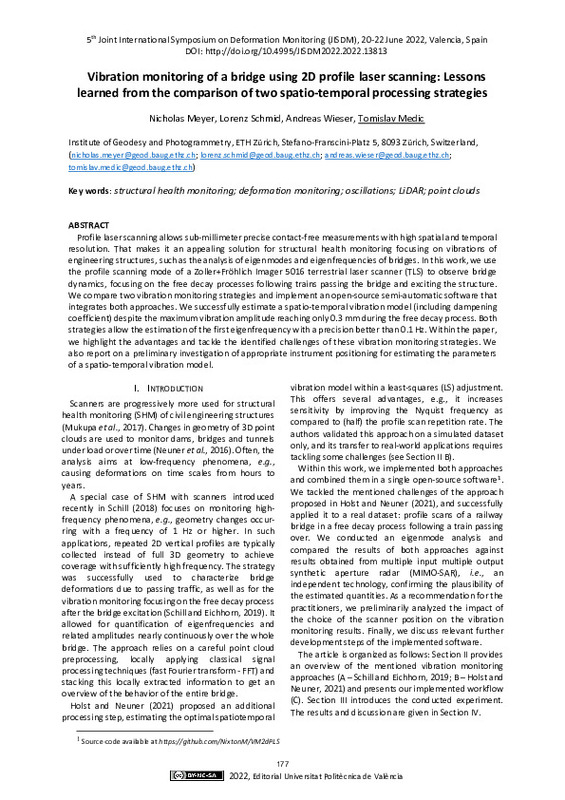JavaScript is disabled for your browser. Some features of this site may not work without it.
Buscar en RiuNet
Listar
Mi cuenta
Estadísticas
Ayuda RiuNet
Admin. UPV
Vibration monitoring of a bridge using 2D profile laser scanning: Lessons learned from the comparison of two spatio-temporal processing strategies
Mostrar el registro sencillo del ítem
Ficheros en el ítem
| dc.contributor.author | Meyer, Nicholas
|
es_ES |
| dc.contributor.author | Schmid, Lorenz
|
es_ES |
| dc.contributor.author | Wieser, Andreas
|
es_ES |
| dc.contributor.author | Medic, Tomislav
|
es_ES |
| dc.date.accessioned | 2023-02-22T08:31:19Z | |
| dc.date.available | 2023-02-22T08:31:19Z | |
| dc.date.issued | 2023-01-27 | |
| dc.identifier.isbn | 9788490489796 | |
| dc.identifier.uri | http://hdl.handle.net/10251/192003 | |
| dc.description.abstract | [EN] Profile laser scanning allows sub-millimeter precise contact-free measurements with high spatial and temporal resolution. That makes it an appealing solution for structural health monitoring focusing on vibrations of engineering structures, such as the analysis of eigenmodes and eigenfrequencies of bridges. In this work, we use the profile scanning mode of a Zoller+Fröhlich Imager 5016 terrestrial laser scanner (TLS) to observe bridge dynamics, focusing on the free decay processes following trains passing the bridge and exciting the structure. We compare two vibration monitoring strategies and implement an open-source semi-automatic software that integrates both approaches. We successfully estimate a spatio-temporal vibration model (including dampening coefficient) despite the maximum vibration amplitude reaching only 0.3 mm during the free decay process. Both strategies allow the estimation of the first eigenfrequency with a precision better than 0.1 Hz. Within the paper, we highlight the advantages and tackle the identified challenges of these vibration monitoring strategies. We also report on a preliminary investigation of appropriate instrument positioning for estimating the parameters of a spatio-temporal vibration model. | es_ES |
| dc.format.extent | 8 | es_ES |
| dc.language | Inglés | es_ES |
| dc.publisher | Editorial Universitat Politècnica de València | es_ES |
| dc.relation.ispartof | 5th Joint International Symposium on Deformation Monitoring (JISDM 2022) | |
| dc.rights | Reconocimiento - No comercial - Compartir igual (by-nc-sa) | es_ES |
| dc.subject | Structural health monitoring | es_ES |
| dc.subject | Deformation monitoring | es_ES |
| dc.subject | Oscillations | es_ES |
| dc.subject | Light detection and ranging (LiDAR) | es_ES |
| dc.subject | Point clouds | es_ES |
| dc.title | Vibration monitoring of a bridge using 2D profile laser scanning: Lessons learned from the comparison of two spatio-temporal processing strategies | es_ES |
| dc.type | Capítulo de libro | es_ES |
| dc.type | Comunicación en congreso | es_ES |
| dc.identifier.doi | 10.4995/JISDM2022.2022.13813 | |
| dc.rights.accessRights | Abierto | es_ES |
| dc.description.bibliographicCitation | Meyer, N.; Schmid, L.; Wieser, A.; Medic, T. (2023). Vibration monitoring of a bridge using 2D profile laser scanning: Lessons learned from the comparison of two spatio-temporal processing strategies. En 5th Joint International Symposium on Deformation Monitoring (JISDM 2022). Editorial Universitat Politècnica de València. 177-184. https://doi.org/10.4995/JISDM2022.2022.13813 | es_ES |
| dc.description.accrualMethod | OCS | es_ES |
| dc.relation.conferencename | 5th Joint International Symposium on Deformation Monitoring | es_ES |
| dc.relation.conferencedate | Junio 20-22, 2022 | es_ES |
| dc.relation.conferenceplace | València, España | es_ES |
| dc.relation.publisherversion | http://ocs.editorial.upv.es/index.php/JISDM/JISDM2022/paper/view/13813 | es_ES |
| dc.description.upvformatpinicio | 177 | es_ES |
| dc.description.upvformatpfin | 184 | es_ES |
| dc.type.version | info:eu-repo/semantics/publishedVersion | es_ES |
| dc.relation.pasarela | OCS\13813 | es_ES |








